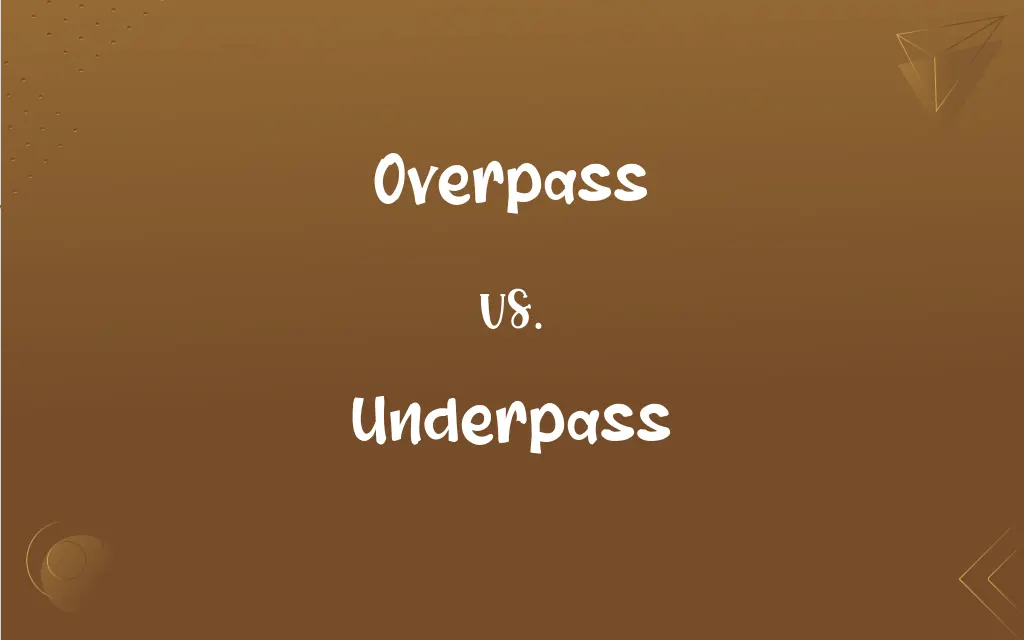Overpass vs. Underpass: What's the Difference?
Edited by Janet White || By Harlon Moss || Updated on November 7, 2023
An overpass is a bridge that carries traffic over a road, while an underpass is a tunnel that allows traffic to pass under a barrier.

Key Differences
An overpass is a structure that allows movement over obstacles without interfering with the traffic below. It is elevated, enabling one route to cross over another. Conversely, an underpass is designed to go beneath an obstruction, allowing a smooth transition without disrupting the flow above.
An overpass serves the purpose of uninterrupted conveyance for vehicles, pedestrians, or trains above ground level. It provides a solution to traffic congestion. On the flip side, an underpass is generally a passageway built under a physical barrier, primarily used to avoid interruptions in movement on the surface.
The overpass is commonly constructed as part of highway systems to provide a seamless flow of traffic on multiple levels. Underpasses, however, are often found in urban settings, providing pedestrians or vehicles a path beneath busy intersections or roads.
Safety and convenience are hallmarks of overpass construction, which allows higher-speed travel without the risk of cross-traffic. In contrast, underpasses are typically associated with slower traffic speeds, designed for safe pedestrian or vehicular crossings in high-traffic areas.
While both overpasses and underpasses are solutions for traffic management, they are applied differently based on the infrastructure needs. An overpass might dominate the skyline with its elevated structure, whereas an underpass remains relatively inconspicuous, integrated into the landscape.
ADVERTISEMENT
Comparison Chart
Structure
Elevated bridge crossing over a road or obstacle
Tunnel or road going beneath a road or obstacle
Purpose
Facilitates traffic above another route
Allows traffic to pass underneath a barrier
Typical Use
Used in highway systems for uninterrupted travel
Used in urban areas for pedestrian or vehicle crossing
Traffic Flow
Enables higher-speed vehicle traffic
Accommodates slower-speed or pedestrian traffic
Visibility
Prominent and visible as part of the landscape
Less visible, often integrated into the urban environment
ADVERTISEMENT
Overpass and Underpass Definitions
Overpass
A bridge that carries one road over another.
The new overpass reduced congestion significantly.
Underpass
A passage beneath a road or railway.
The new underpass eased the pedestrian traffic downtown.
Overpass
An elevated structure for crossing obstacles.
They built an overpass to improve highway safety.
Underpass
A lower-level route for safe crossing under a barrier.
The underpass provides safe access to the opposite side of the park.
Overpass
A raised pathway for vehicles or pedestrians.
The pedestrian overpass made crossing the street safer.
Underpass
A tunnel allowing vehicles to travel underneath an obstacle.
The truck was too tall to fit through the underpass.
Overpass
A construction facilitating overground travel.
The train overpass allowed uninterrupted travel across the city.
Underpass
An infrastructural feature for subsurface transit.
Flooding can be a problem for this underpass during heavy rain.
Overpass
An upper-level crossing in a multi-tiered traffic system.
The overpass connects two major interstates.
Underpass
A conduit for traffic going under a more significant route.
They installed lighting to improve visibility in the underpass.
Overpass
A passage, roadway, or bridge that crosses above another roadway or thoroughfare.
Underpass
A passage underneath something, especially a section of road that passes under another road or a railroad.
Overpass
To pass over or across; traverse.
Underpass
An intersection formed in this way.
Underpass
A passage that crosses a road, railroad or similar obstacle in a tunnel underneath it.
Underpass
An underground tunnel or passage enabling pedestrians to cross a road or railway
FAQs
Can an overpass be used by trains?
Yes, there are overpasses designed for trains.
Are underpasses safe during inclement weather?
They can be if designed with adequate drainage.
What is an overpass used for?
To carry traffic over other roads or obstacles.
How does an underpass benefit pedestrians?
It provides a safe crossing beneath busy streets.
Are there weight limits on overpasses?
Generally, yes, to maintain structural integrity.
What aesthetics considerations are there for underpasses?
They often feature murals or decorative designs.
Do underpasses require regular maintenance?
Yes, to address wear and tear, vandalism, and cleanliness.
What materials are used to build overpasses?
Typically, steel and concrete.
Can an overpass have multiple levels?
Yes, some complex interchanges have several levels.
What features ensure pedestrian safety in underpasses?
Good lighting, signage, and sometimes surveillance systems.
How do overpasses handle earthquake safety?
They are built with seismic considerations in various regions.
Is lighting important in underpasses?
Yes, for safety and visibility.
Do overpasses impact the environment?
Yes, their construction and footprint can have environmental impacts.
Can underpasses be used for anything besides traffic?
Sometimes they double as social spaces or art installations.
How are underpasses designed for flood prevention?
With proper drainage and water management systems.
Can wildlife use overpasses?
Special wildlife overpasses exist for animal crossings.
Are underpasses prone to crime?
They can be, which is why security measures are important.
Do overpasses require special engineering?
Yes, due to their height and weight-bearing requirements.
How do overpasses accommodate bicyclists?
With dedicated bike lanes or adjacent pathways.
What measures prevent underpass flooding?
Pumps and well-designed drainage channels.
About Author
Written by
Harlon MossHarlon is a seasoned quality moderator and accomplished content writer for Difference Wiki. An alumnus of the prestigious University of California, he earned his degree in Computer Science. Leveraging his academic background, Harlon brings a meticulous and informed perspective to his work, ensuring content accuracy and excellence.
Edited by
Janet WhiteJanet White has been an esteemed writer and blogger for Difference Wiki. Holding a Master's degree in Science and Medical Journalism from the prestigious Boston University, she has consistently demonstrated her expertise and passion for her field. When she's not immersed in her work, Janet relishes her time exercising, delving into a good book, and cherishing moments with friends and family.































































